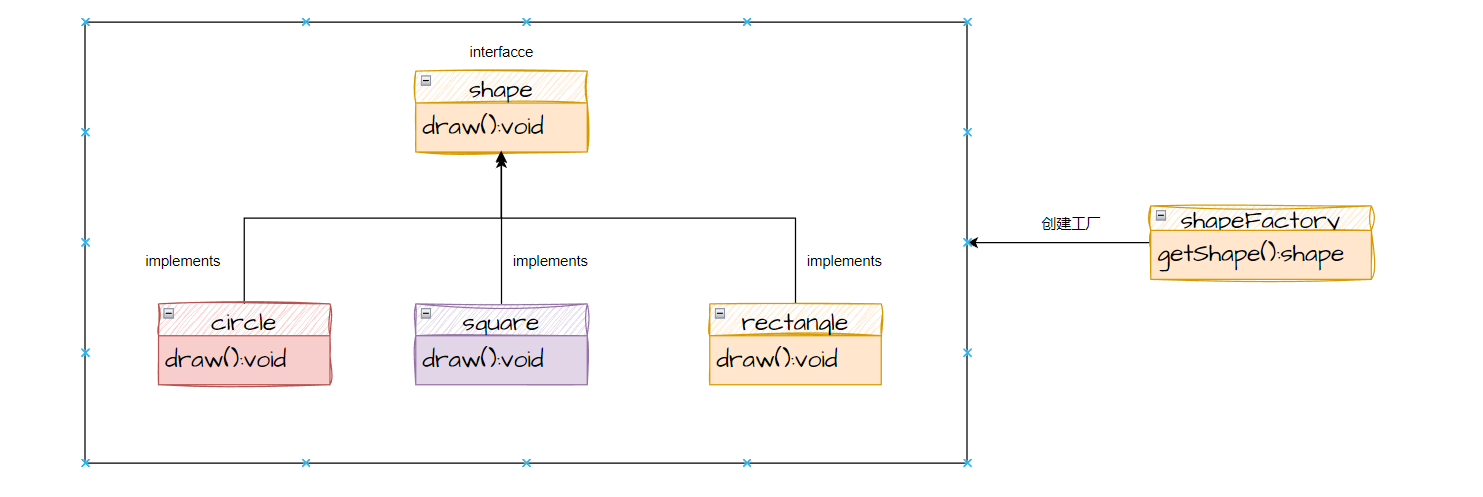C语言工厂模式
前言
工厂模式是在软件设计中常常使用一种设计模式。
在使用工厂模式进行软件开发,在创建对象的过程中,不会对客户端暴露具体的逻辑实现,而是使用一个共有的接口来指向创建的对象。 通过这样的方式进行软件开发好处是,可以在不修改原本的代码的基础上加入新的产品,满足软件设计的开闭原则。
工厂模式的优点
- 使用者在创建对象时,只需要知道该对象的名称即可。
- 代码的扩展性强,如果需要增加一个新的产品,只需要增加一个实现即可。
- 将代码的具体的实现和抽象接口分离。接口一致对外,实现可以根据需求的不同实现不同,实现层与层之间的解耦。
工厂模式的缺点
- 产品增加时,对应的实现会变多,系统的复杂度会增加。
- 实现和接口分离,可能使得代码变得相对不易理解。
应用场景
- 一个系统要独立于它的产品的创建、组合和表示,即要将具体产品类分离出来。
- 一个系统要有多个产品系列中的一个来配置,即系统有多个产品系列,但只使用一个产品系列。
- 提供一个产品类库,但只想显示它们的接口而不是实现。
案例

为了说明工厂模式,我这里举一个比较简单的例子。假设有shape这个接口,然后根据业务的不同有可能需要circle的实现方式也有可能时square的实现方式,当然也有可能时其他的具体形状,但是抽象出现就是一个形状和将这形状绘制的函数draw即可。
创建Shape接口并实现
typedef struct Shape Shape;
struct Shape
{
void *priv_;
void (*Draw)(struct Shape *c_this);
void (*Destroy)(struct Shape *c_this);
};
void ShapeDraw(Shape *c_this);
void ShapeDestory(Shape **c_this);
void ShapeDraw(Shape *c_this)
{
assert(c_this != NULL);
if(c_this->Draw != NULL)
{
c_this->Draw(c_this);
}
}
void ShapeDestory(Shape **c_this)
{
if(c_this == NULL || *c_this == NULL)
{
return;
}
Shape *shape = *c_this;
if(shape->Destroy != NULL)
{
shape->Destroy(shape);
}
free(*c_this);
*c_this = NULL;
}
创建并实现工厂类ShapeFactory
#include "shape.h"
Shape* ShapeFactoryCreateShape(const char *shape_type);
extern struct Shape* CircleCreate(void);
extern struct Shape* RectangleCreate(void);
extern struct Shape* SquareCreate(void);
Shape* ShapeFactoryCreateShape(const char *shape_type)
{
if(shape_type == NULL)
{
return NULL;
}
if (0 == strcasecmp("CIRCLE", shape_type))
{
return CircleCreate();
}
else if (0 == strcasecmp("RECTANGLE", shape_type))
{
return RectangleCreate();
}
else if (0 == strcasecmp("SQUARE", shape_type))
{
return SquareCreate();
}
else
{
return NULL;
}
}
- 创建实现接口的实体类
//1.Circle类
static void CircleDraw(struct Shape *c_this)
{
printf("Circle draw method.\n");
}
struct Shape *CircleCreate(void)
{
struct Shape *c_this = (struct Shape *)malloc(sizeof(struct Shape));
if(c_this == NULL) {
return NULL;;
}
memset(c_this, 0, sizeof(struct Shape));
c_this->Draw = CircleDraw;
return c_this;
}
//2.Rectangle类
static void RectangleDraw(struct Shape *c_this)
{
printf("Rectangle draw method.\n");
}
struct Shape *RectangleCreate(void)
{
struct Shape *c_this = (struct Shape *)malloc(sizeof(struct Shape));
if(c_this == NULL)
{
return NULL;;
}
memset(c_this, 0, sizeof(struct Shape));
c_this->Draw = RectangleDraw;
return c_this;
}
//3.Square类
static void SquareDraw(struct Shape *c_this)
{
printf("Square draw method.\n");
}
struct Shape *SquareCreate(void)
{
struct Shape *c_this = (struct Shape *)malloc(sizeof(struct Shape));
if(c_this == NULL)
{
return NULL;;
}
memset(c_this, 0, sizeof(struct Shape));
c_this->Draw = SquareDraw;
return c_this;
}
- FactoryPatternDemo类使用ShapeFactory来获取Shape对象
void main(void)
{
//获取 Circle 的对象,并调用它的 draw 方法
Shape* circle_shape = ShapeFactoryCreateShape("CIRCLE");
ShapeDraw(circle_shape);
ShapeDestory(&circle_shape);
//获取 Rectangle 的对象,并调用它的 draw 方法
Shape* rectangle_shape = ShapeFactoryCreateShape("RECTANGLE");
ShapeDraw(rectangle_shape);
ShapeDestory(&rectangle_shape);
//获取 Square 的对象,并调用它的 draw 方法
Shape* square_shape = ShapeFactoryCreateShape("SQUARE");
ShapeDraw(square_shape);
ShapeDestory(&square_shape);
system("pause");
}


 浙公网安备 33010602011771号
浙公网安备 33010602011771号